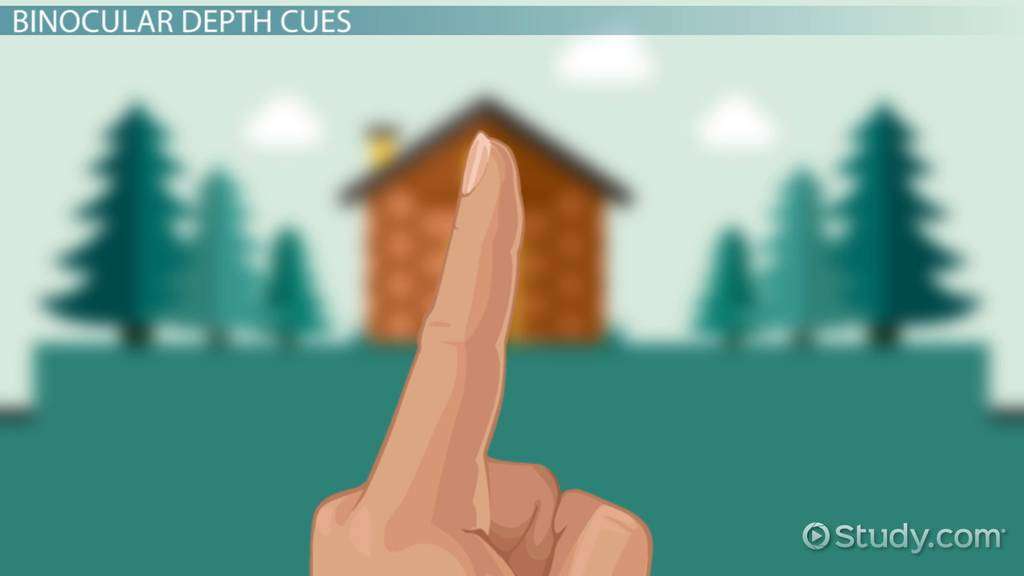How is Depth Perception Created?
Depth perception is created when the eyes and the brain work together in an effort to perceive the depth, or the length, width, and height, of the world around us. Humans have two eyes. Having two eyes to see through is called binocular vision. Binocular vision helps to create a stronger sense of depth perception than monocular vision or having one eye. This is because the brain can get a view from two different angles, thus seeing the same object or room from a slightly different length, width, and height, through both eyes. When the images are compiled within the brain and one image is produced for us to comprehend or ‘see’ then we can perceive depth. When looking at a small object, humans have the ability to turn both of their eyes in slightly. This effect is called convergence and it allows for a closer look at small objects, which allows the brain to better perceive the length, width, and height of the object within space. Depth perception examples include:
- Knowing how close someone is when they are walking toward us.
- Having a pencil and a mug on the desk and being able to tell which one is closer.
- Seeing a dog running away and knowing how far away it is.
Seeing a dog running and knowing how close it is.

Binocular and Monocular Depth Cues
There are a variety of visual cues to help a person determine the depth of the world around them and have special awareness both in the monocular and binocular sense. Binocular depth cues are all of the ways that both eyes can help to perceive the world around us. Monocular depth cues are all the ways that just one eye can see the world around us and help us to perceive it. There are a few important terms to know when discussing depth cues.
Binocular depth cues include:
- Retinal disparity which is the slightly different images a person’s two eyes send to the brain.
- Fusion is where the brain combines two different images to make it into one.
Monocular depth cues include:
- Shadow stereopsis refers to the perceptions of areas that are in the shadows and how they are perceived by people with normal binocular vision. These areas are perceived differently by the eyes because they do not have defined outlines, but instead have gradients.
- Relative size of an object refers to the size that the object looks. Objects that are farther away look smaller to the eye, while objects that are closer up look larger.
- Texture gradient is an example of linear perspective. Objects that are farther away or extend farter away from us such as a cornfield will appear to have a finer, smoother texture the farther out it is. The texture will be more defined with close-up objects.
- Interposition is the perception that one object is covering another object because it is in front of it. It is a position cue.
- Motion parallax refers to objects that appear to move faster if they are closer to a person, and objects appearing to move slower if they are farther away from a person. This is due to the perceived distance that the object is traveling.
Evolution of Depth Perception
Humans have good depth perception because their eyes are close together and face in front of them. This allows the vision that they see through binocular eyes to overlap. When the vision overlaps it improves the brain’s ability to perceive depth.
Many animals such as chickens, fish, and horses have eyes on the sides of their heads, this gives them a good panoramic view of the world, but it does not give them very good depth perception. Since their eyes have two different views of the world, and the images do not overlap, the brain is only processing each eye according to monocular depth cues, or one-eye depth.
Donkeys and chickens have less depth perception than cats or dogs.

Many of these discoveries were noted first by Charles Wheatstone in the Victorian era. He invented the stereoscope in the 1830s which allowed for the study of binocular vision to begin.
Wheatstone worked with retinal disparities to test the limits of the brain to see how different the images seen through each eye were. He also did experiments changing what each eye saw using the stereoscope to determine if the brain could process the images separately or together. He concluded that a person was able to view the different images easily. There are multiple theories on depth perception which include the Law of Newton-Muller-Gudden, and the Eye-Forelimb EF Hypothesis which will be discussed within this lesson.
The Law of Newton-Muller-Gudden
Isaac Newton first theorized that the side of the body the eye is on sends signals to the corresponding side of the brain, specifically the right and left hemispheres. The right eye would send signals to the right hemisphere. The left eye would send signals to the left hemisphere. The Law of Newton-Muller-Gudden involves the scientific principles that show how the structure of the brain, eyes, and nerves are interconnected. The Law of Newton-Muller-Gudden states that “the retinohypothalamic nerve, a neural input pathway, obeys the principle that the degree of optic fiber decussation in the eye cavity is inversely related to the front-facing portion of the optical axes of the eyes.” The term decussation means that what is seen if there is a flaw in the fibers on one side of the eye will have an effect on the other side of the body.
This Law has been disputed as recently as 2016 by a variety of scientists who have studied 23 species types from 11 different orders to discover that the opposite could be true. This theory is heavily debated in ocular science.
The Eye-Forelimb EF Hypothesis
Another theory on depth perception is the Eye-Forelimb EF Hypothesis, which suggests that the development of depth perception and make up of visual structures needed for depth perception stemmed from a need to better control forelimbs.
E.J. Gibson and R.D. Walk developed an experiment to test when depth perception develops in babies and animals. They discovered that it was developed around the time a baby could craw, or when a baby needs better control of his or her limbs. The experiment was called the visual cliff test. Plexiglass was placed over a drop-off. The babies were placed on one side, and the caregiver on the other side. Walk and Gibson hypothesized that if depth perception had already developed then the babies would be hesitant to cross over the plexiglass. They were proven correct.
Poor Depth Perception
People and other living organisms experience problems with poor depth perception. Some animals, like pigeons, use head movement to compensate for issues related to poor depth perception. There is a potential danger when humans have bad depth perception. Humans are supposed to have good depth perception to navigate the world around them. Poor depth perception can cause problems when driving, working, or just walking around the world.
Testing Depth Perception
One way to test depth perception is to put a photo of a golf ball on your wall about 6 inches in front of your eyes. Then, using your finger, hover it in front of the golf ball.
Then, focus on the golf ball and you will see the ball clearly, but you will also see two slightly blurry images of your finger on either side of the tennis ball.
After you are finished, then focus on your finger, and the ball should appear to be cut in half.
Golf ball for testing depth perception.

Disorders and Causes
There are several disorders that can cause a person to have depth perception issues, and these include:
- Strabismus: both eyes do not line up in the same direction, also known as cross-eyed.
- Amblyopia: a lazy eye
These disorders cause poor depth perception because they change the view that is coming from one or both eyes. When the view is not overlapping correctly, to give the brain two similar images that it can process, then the resulting image the person comprehends will lack depth perception.
Blindness in one eye or the loss of an eye can also create poor depth perception because it leaves a person to rely only on monocular depth cues. Though there is no cure for blindness, there are some common treatments for the disorders listed above. For strabismus, the treatments include one of the following:
- Eyeglasses
- Vision therapy
- Muscle surgery
For Amblyopia, the treatment includes an eye patch over the afflicted eye until it is corrected.
Lesson Summary
In summary, depth perception is created by the brain working closely with the eyes. There are two different types of depth perception cues which include:
- Binocular depth perception cues
- Monocular depth perception cues
Depth perception has been studied for many years, and tests for depth perception were used as of the 1930s when the stereoscope was invented. Depth perception occurs in babies around the time they learn to crawl, as it helps babies to perceive their environment. Poor depth perception can be caused by a few disorders which include a lazy eye and issues with crossed eyes. Some of these issues can be corrected with the appropriate therapies.
Depth Perception
Depth perception is the ability to see things in three dimensions (including length, width and depth), and to judge how far away an object is.
For accurate depth perception, you generally need to have binocular (two-eyed) vision. In a process called convergence, our two eyes see an object from slightly different angles and our brain compares and processes the two sets of information to form a single image. When both eyes see clearly and the brain processes a single image effectively, it is called stereopsis.
People who rely on vision primarily in one eye (called monocular vision) may struggle with depth perception. However, some people who have had good vision in one eye for a long period of time may find they have acceptable depth perception. This is because their brain has adjusted in various ways to make up for the limited visual input from one eye.
Some conditions that can cause depth perception problems include:
- Blurry vision, usually in one eye
- Strabismus
- Amblyopia
- Nerve problems in one eye
- Trauma to one eye
If you suspect you are having trouble with your depth perception, talk with your ophthalmologist.
Depth perception is the ability to perceive the world in three dimensions (3D) and to judge the distance of objects. Your brain achieves it by processing different pictures from each eye and combining them to form a single 3D image.
Depth perception makes it possible for your eyes to determine distances between objects and to tell if something is near to you or far away.
![]()
Mamoru Muto / Aflo
Visual Cues and Depth Perception
Depth perception relies on visual cues. These cues are the physical signals and the brain’s interpretation of them, which are responsible for your vision as the brain and your body work together.
In order to have depth perception, you must have binocular vision, also known as stereopsis. You also rely on monocular cues from each eye separately, as well as oculomotor cues that arise from the way your eyes move together to keep focus.
Monocular Cues
Monocular cues allow for some sense of depth perception even when you don’t have two eyes working properly together. They’re still needed even when they are, offering cues including:
- Motion parallax: This cue contributes to your sense of self-motion. It occurs when you move your head back and forth. Objects at different distances move at slightly different speeds. Closer objects move in the opposite direction of your head motion and faraway objects move with your head.
- Interposition: When objects overlap each other, it gives us monocular cues about which one is closer.
- Aerial perspective: Color and contrast cues offer clues as to how far away an object might be. As light travels, it scatters and causes blurred outlines, which your brain interprets as being farther away.
Binocular Cues
The most important aspect of binocular vision is having two eyes. People with vision from only one eye have to rely on other visual cues to gauge depth, and their depth perception is generally less accurate.
Not having accurate depth perception can have a major impact on your life, from early childhood learning to what jobs you’re able to do. That’s because your binocular cues are at work to create the depth perception needed for countless tasks.
Some of the cues provided through your binocular vision include:
- Changing disparity: These cues are a function of stereopsis, which allows your eyes to build depth perception on the basis of the distance between them. This sensitivity to the disparity, and how the brain processes the slight difference, contributes to an accurate 3D image.
- Velocity differences: Your binocular vision is responsible for processing differences in speed, or velocity, that contribute to depth perception as you and the world you interact with are in motion.
Oculomotor Cues
These cues are based on the way your eye muscles work, and include two key features known as convergence and accommodation. Here’s what these oculomotor cues do:
- Convergence: This describes the way your eyes angle inward when you look at an object up close. This motion is at work when you’re focusing on something that’s only a short distance away.
- Accommodation: This cue also only works at short distances. Your eye muscles change the focus of the eye lens, helping you to see different objects at different distances with accurate depth perception.
These eye motions allow your eyes to work together to focus on an object with accurate depth perception.
Causes of Impaired Depth Perception
A lack of depth perception can be caused by numerous conditions. These include:
- Amblyopia: Also called “lazy eye,” this is a condition in which one eye is weaker than the other. This typically happens because of abnormal vision development in childhood and features decreased vision in one or both eyes.
- Optic nerve hypoplasia: This occurs when the optic nerve, which sends visual signals from your eyes to your brain, has incomplete development before birth. It can result in partial or total vision loss in children.
- Strabismus: This occurs when the eyes point in different directions, such as one pointing straight ahead and the other pointing inward or down. In this case, the strabismus causes amblyopia.
- Blurry vision: Numerous conditions can cause the vision in one or both eyes to be blurry, as can trauma to an eye. Blurry vision causes amblyopia.
- Injury to one eye: Trauma can alter your vision, either temporarily or permanently.
Depth perception issues can impact your life in several ways. They can:
- Affect a child’s ability to learn
- Cause problems driving and navigating roads properly
- Prevent an athlete from reaching their full potential
- Stop you from getting a job that requires good depth perception
Depth Perception Tests
Having a comprehensive eye examination is the first step in fully assessing your depth perception.
An optometrist or ophthalmologist will first test your vision by measuring your visual acuity or the quality of your vision. If one eye is very blurry and the other is not, your depth perception will be limited.
When an optometrist checks your eye muscles, they’ll perform a cover test. A cover test measures how well your eyes work together by checking the way one eye behaves when the other eye is covered.
A cover test is used to check for strabismus, such as esotropia (in), exotropia (out), hypertropia (up) and hypotropia (down). This is an eye muscle problem where the eyes do not work well together, or when one eye is turned in, out, up, or down. If the eyes are not in perfect alignment with each other, double vision occurs, or more commonly, suppression.
If your eyes aren’t lined up, your brain will suppress the image from the misaligned eye to keep you from having double vision. As a result, you’re really only using one eye. When this happens, you will not have good depth perception.
Fine levels of depth perception are measured using tests, some of them relying on pictures or cartoons when designed for young children. These tests may include:
- Random dot stereograms, which measure 3D vision by using images made up of dots
- Contour stereotests, which check 3D vision with shapes and images designed to create contours
How Can I Improve Depth Perception?
It’s possible to improve your depth perception, or that of your child, but the treatment will depend on the reason for their depth perception issues.
The lowest levels of intervention include simple strategies such as:
- Eye exercises designed to improve depth perception or boost athletic performance
- Limits on screen time to avoid overuse damage from the type of focus involved
- Improved lighting, often used to maximize depth perception ability in older people
Treatment for a specific condition such as strabismus or amblyopia, in which one eye is weaker than the other, will focus on making that eye stronger. Sometimes this can be done with eyeglasses, eye patches worn for part of the day, or eye drops. If the problem persists, some people may need surgery on their eye muscles to improve depth perception.
Researchers also are currently studying the use of virtual reality (VR) as a promising alternative in treating depth perception problems. One small study of 24 young people, divided into equal groups who played either 3D or 2D video games, found improved binocular vision among the 3D players.
More study is needed, but the use of VR may prove useful in treating amblyopia, strabismus, and other depth perception problems.




